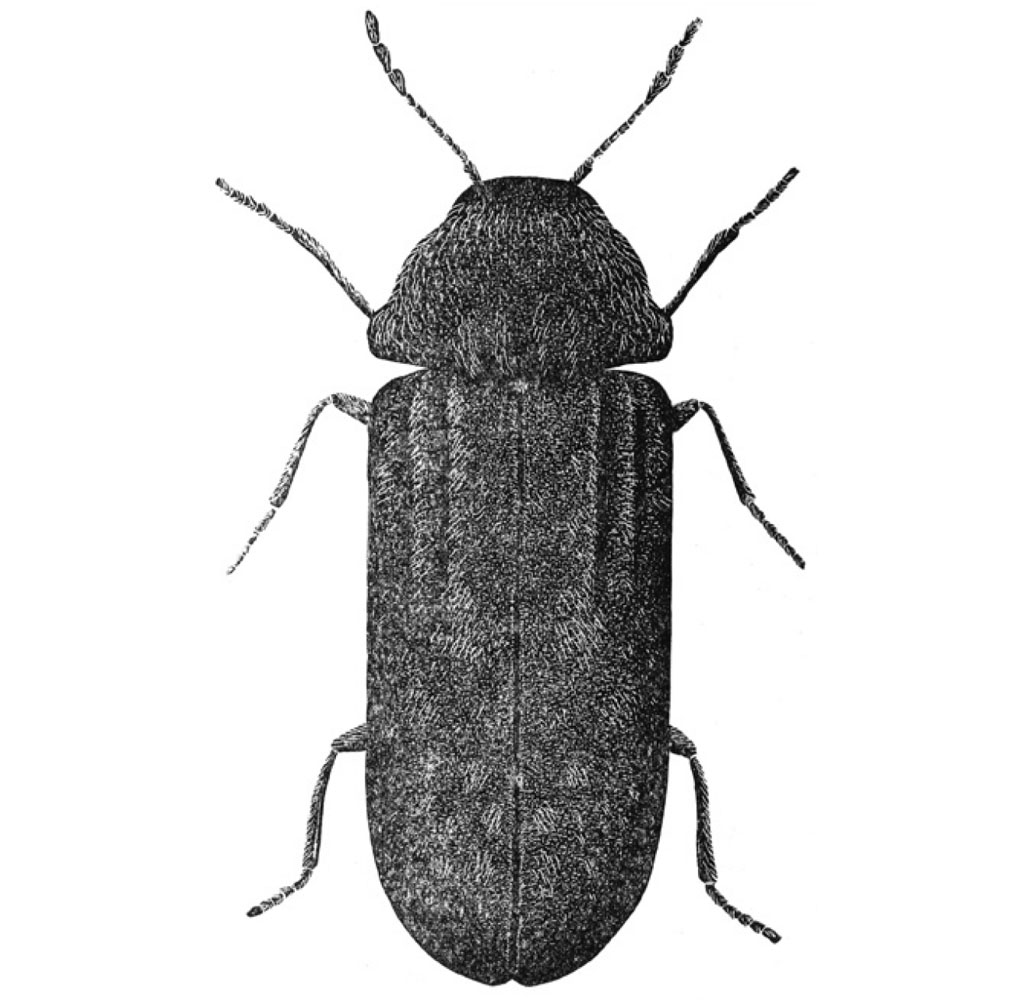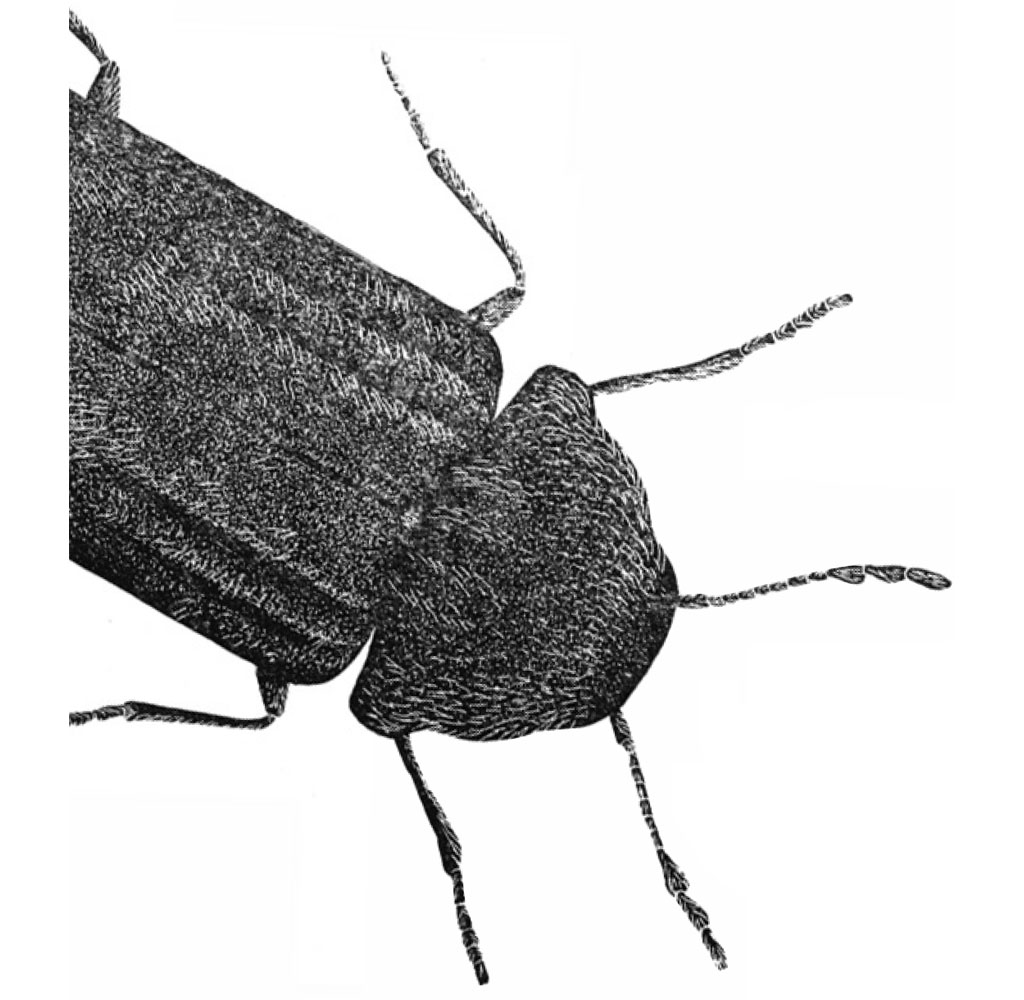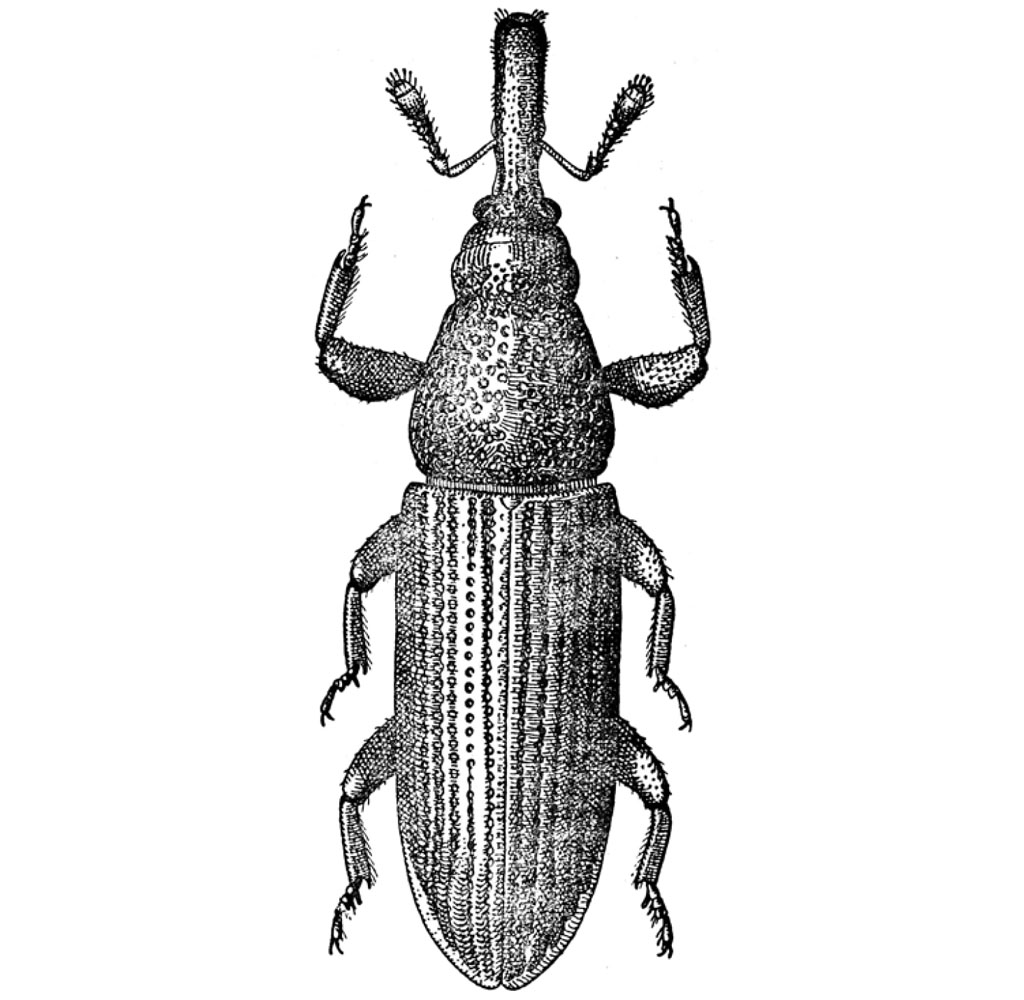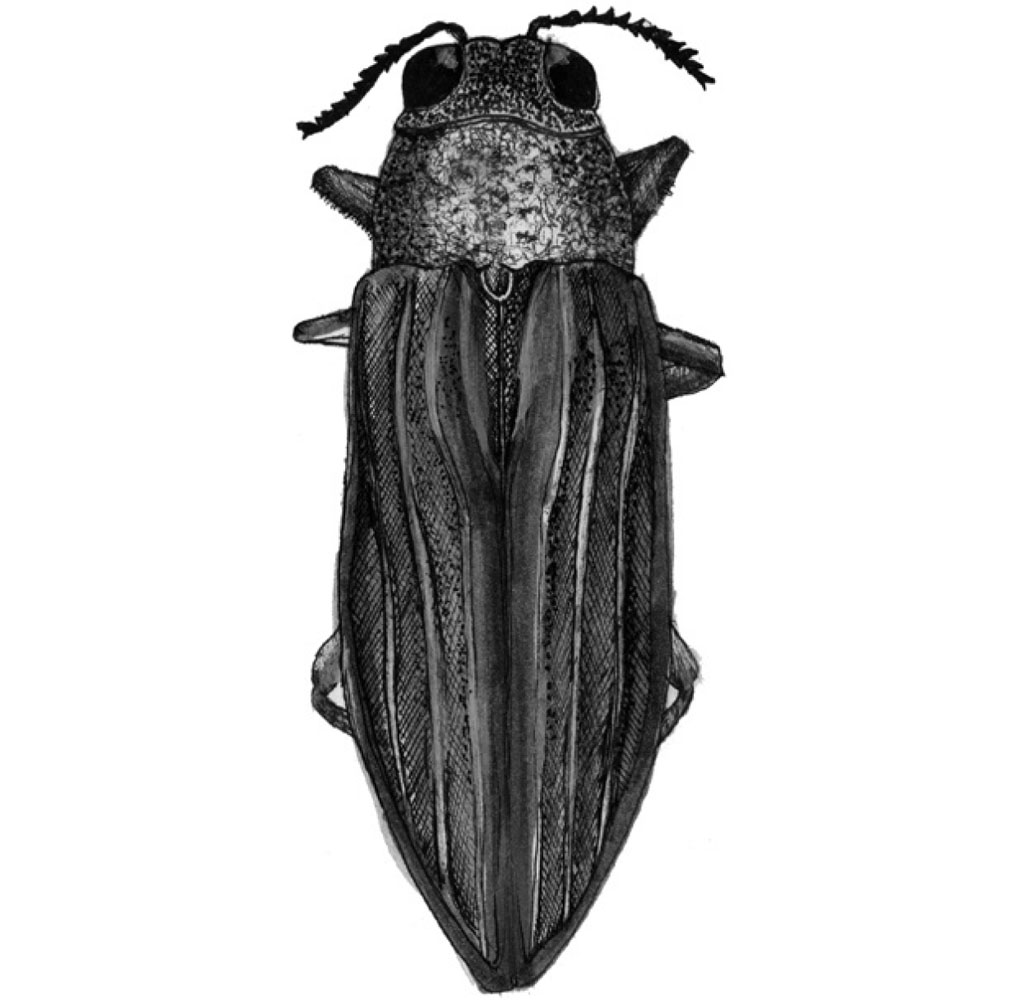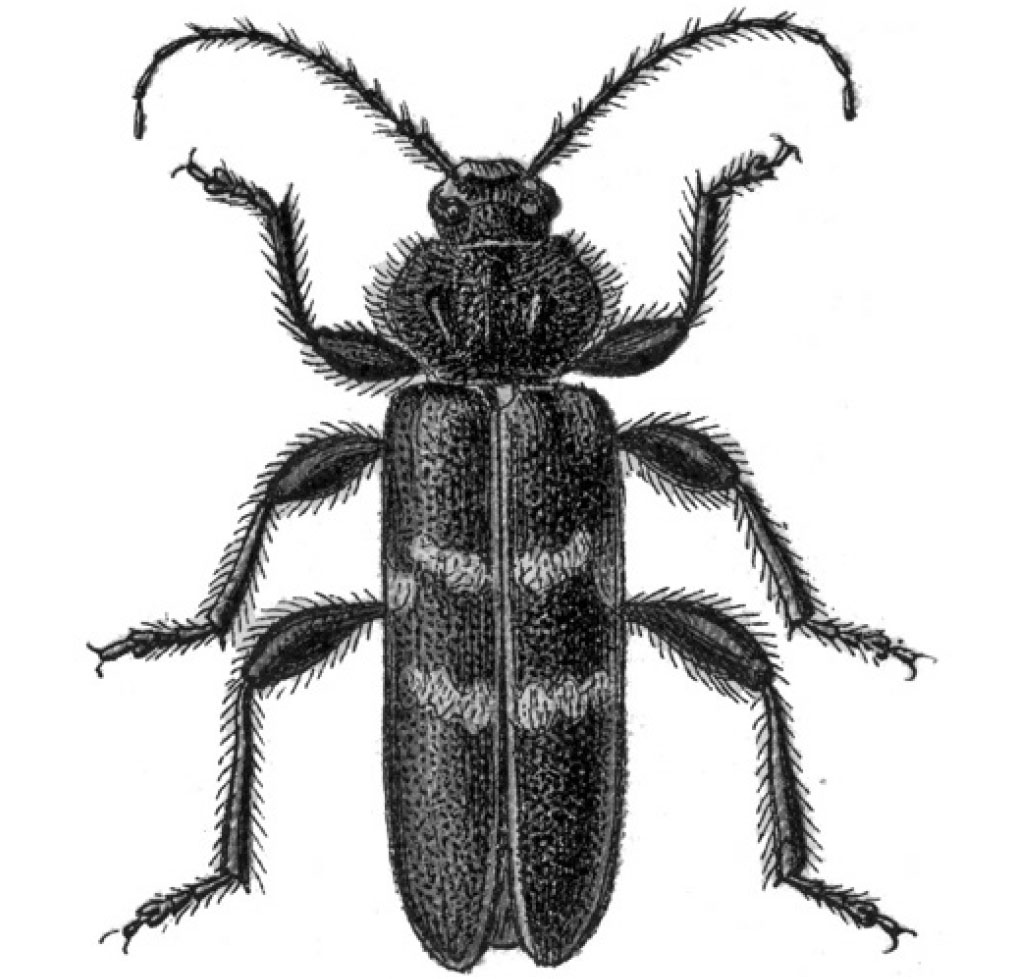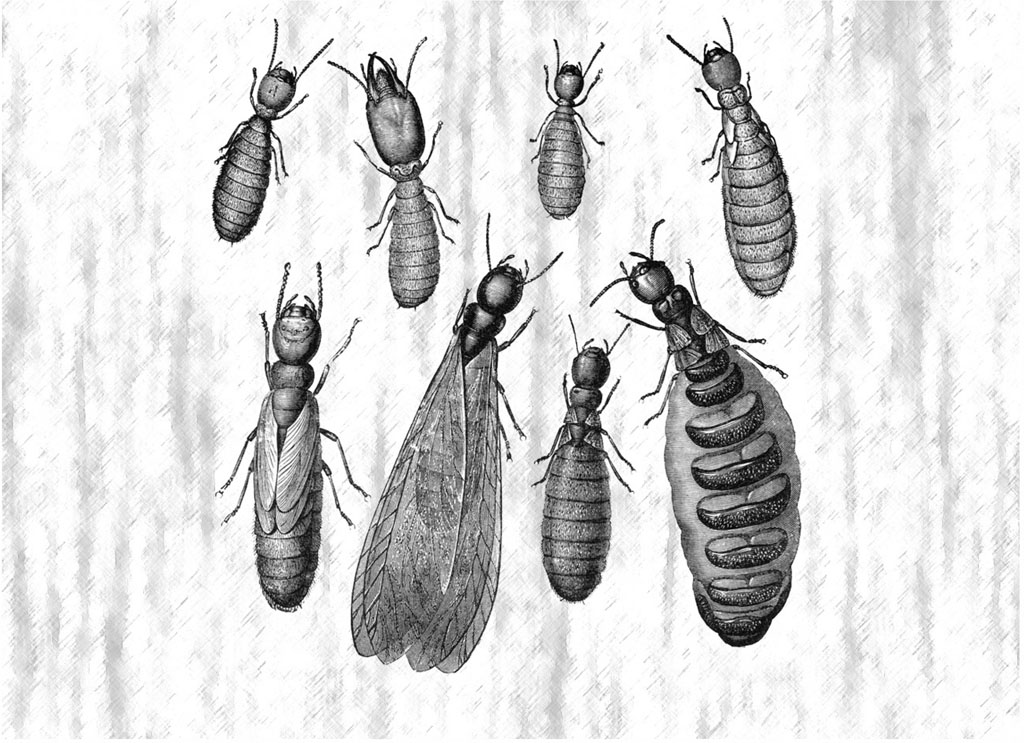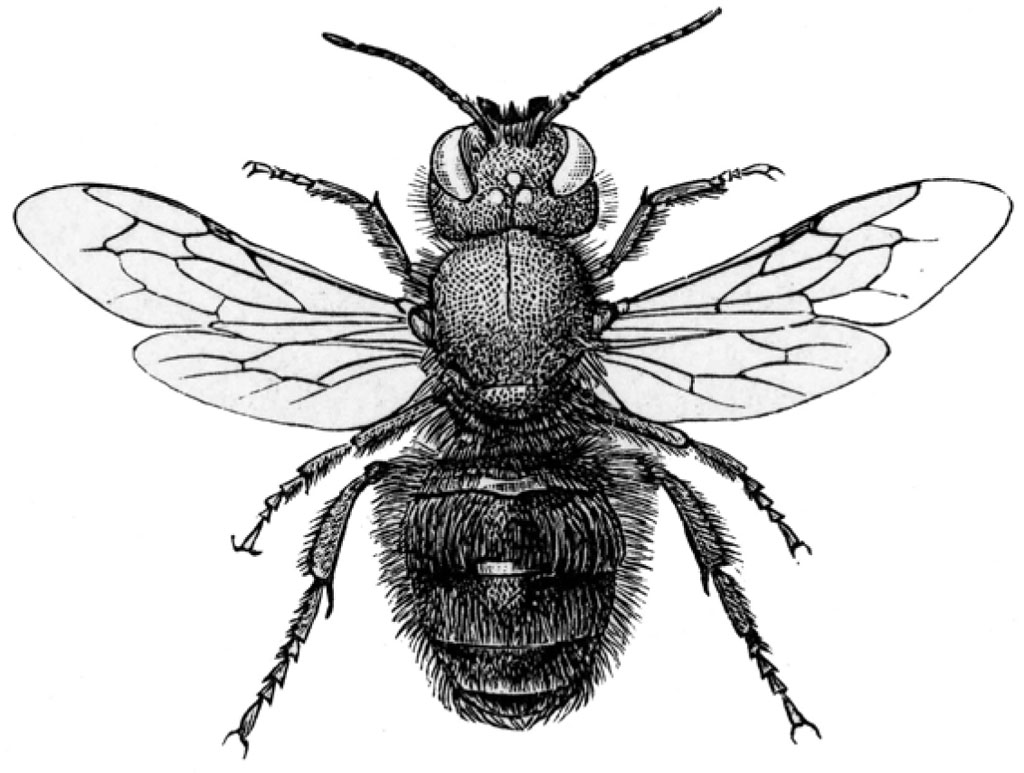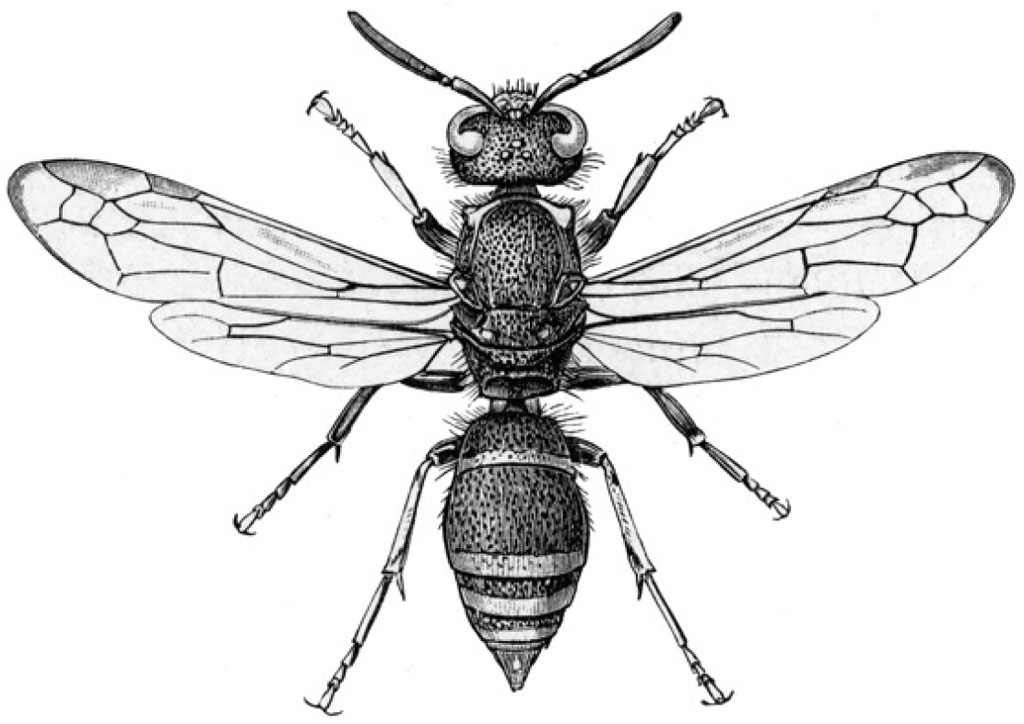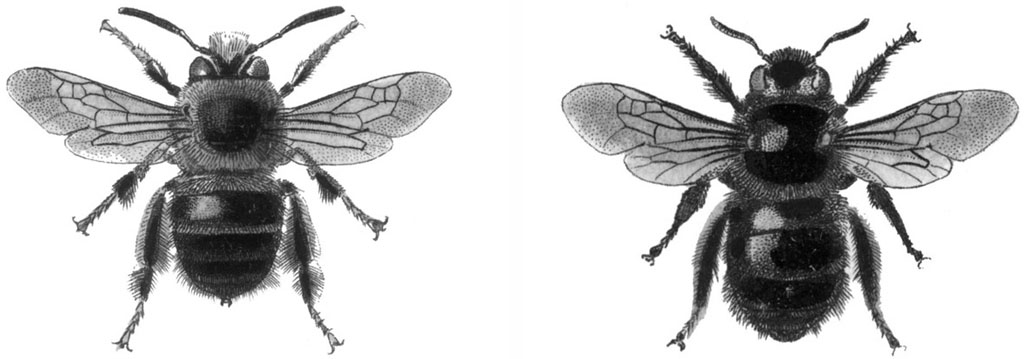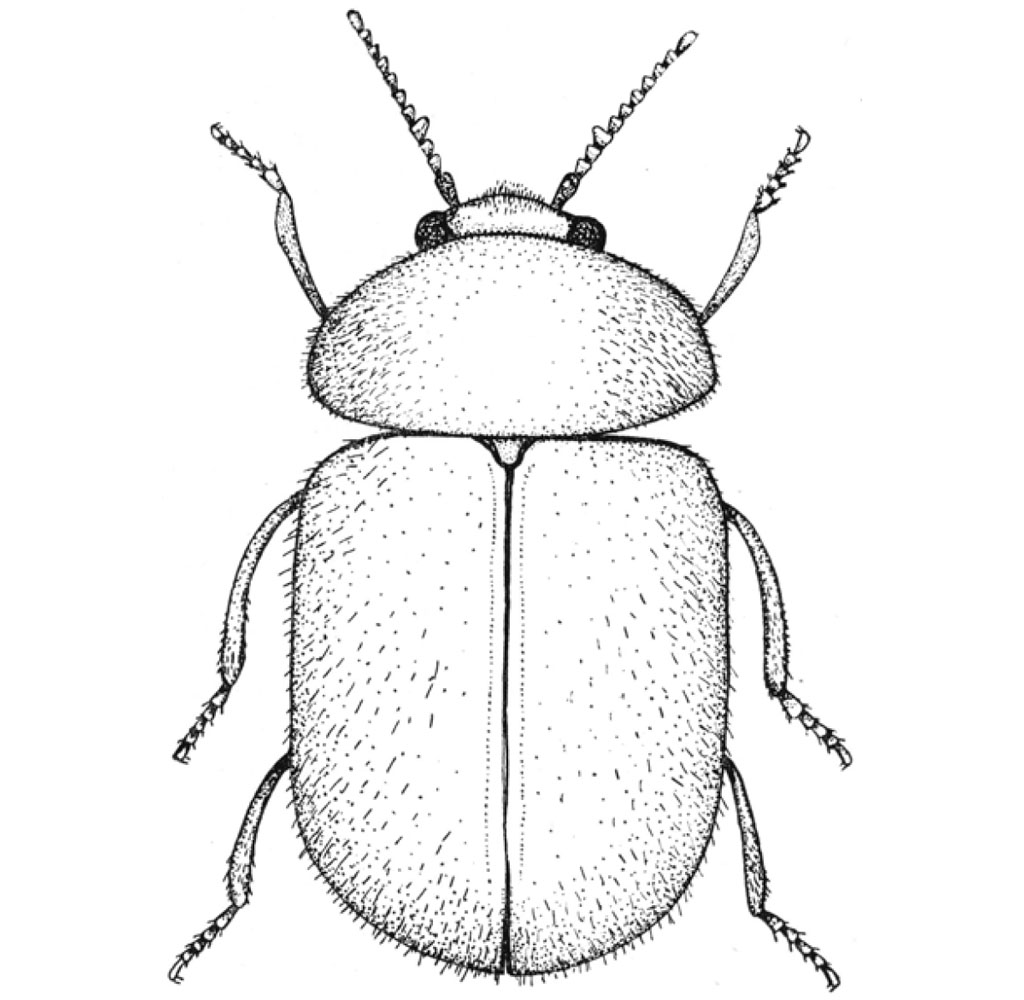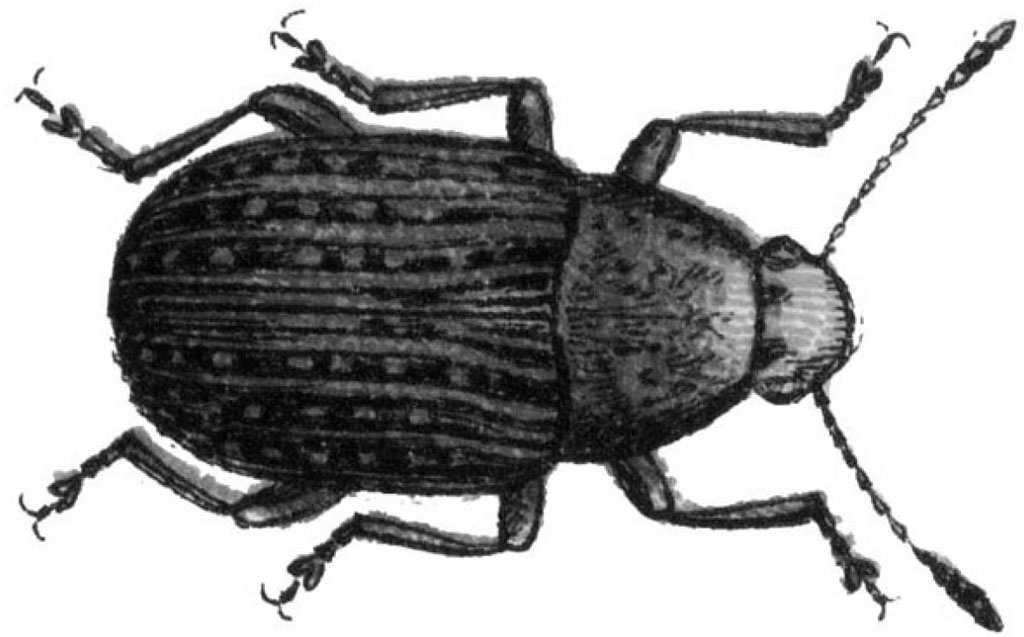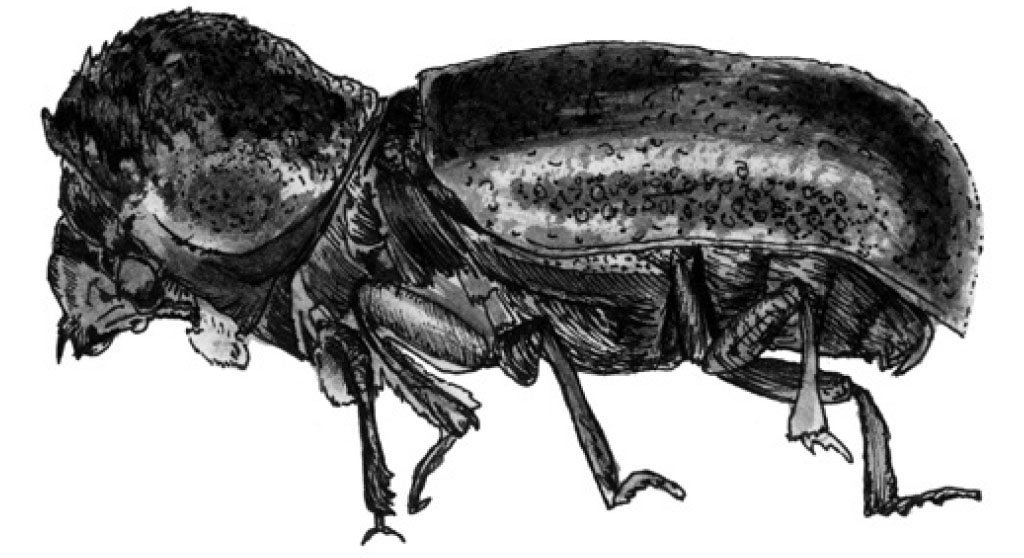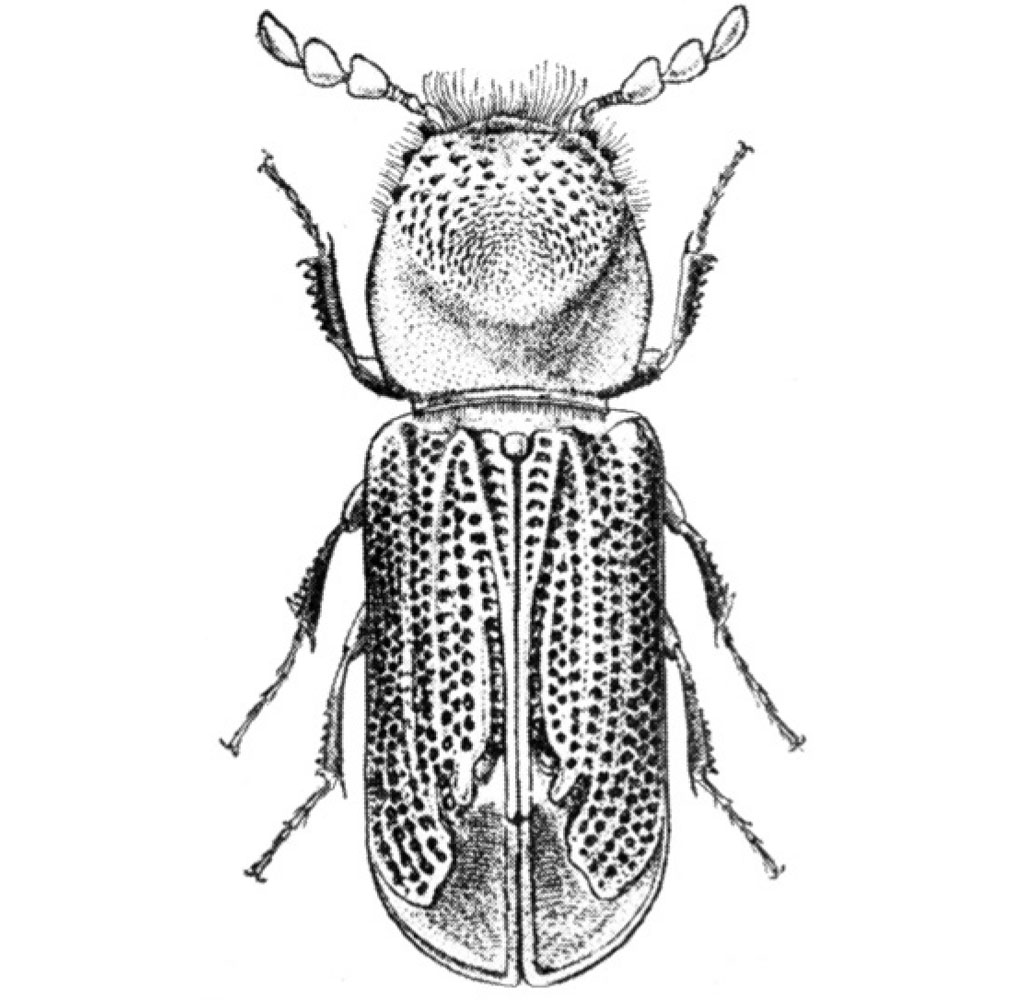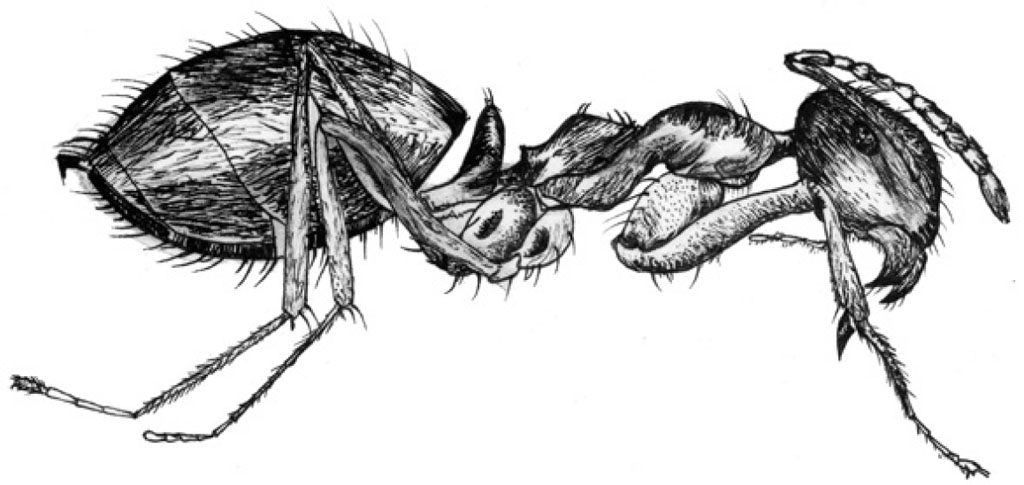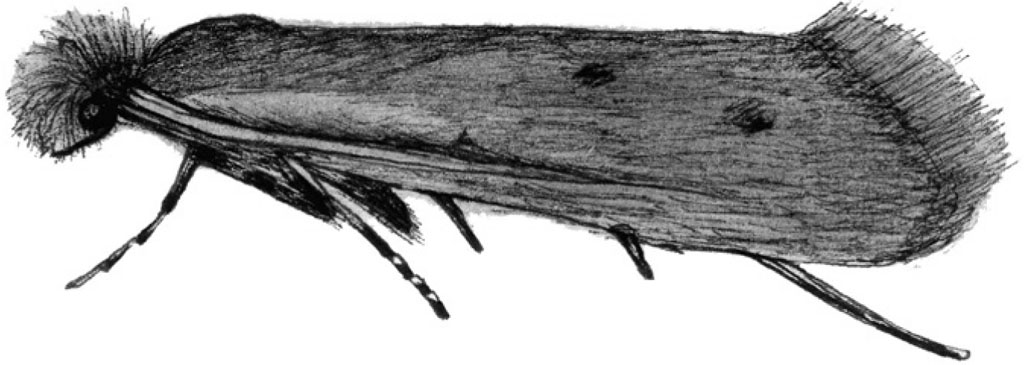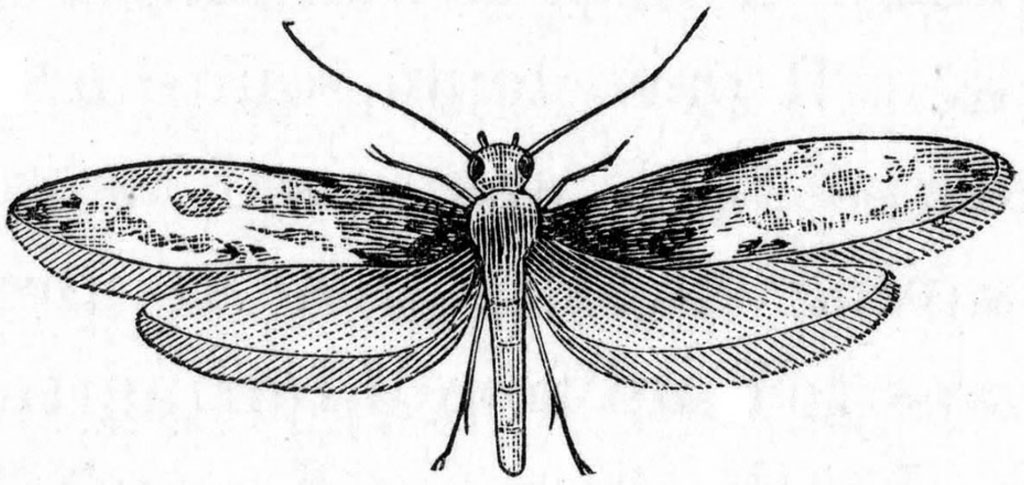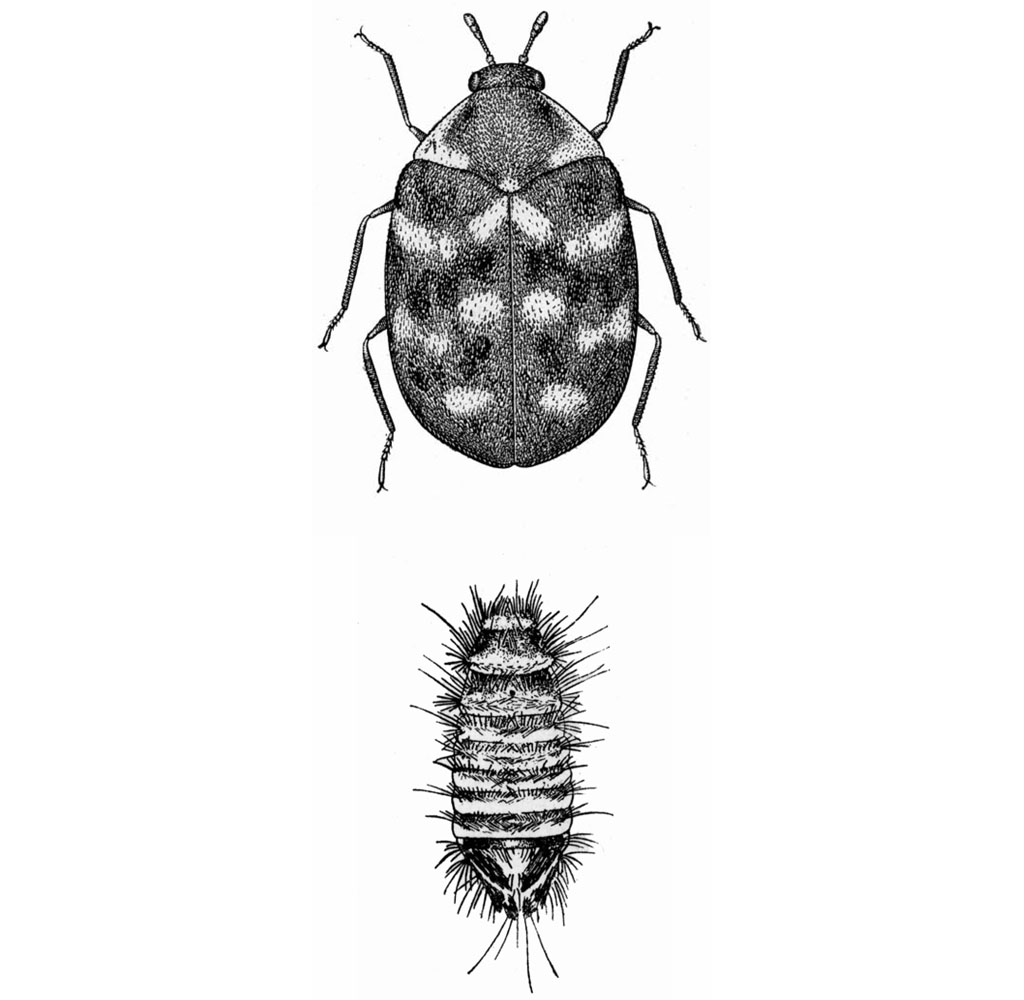WOODWORM, CLOTHES MOTHS AND CARPET BEETLES – THE END OF CIVILISATION AS WE KNOW
IT
Many years ago I was working for the BBC Natural History Unit in Bristol, on the children’s wildlife programme The Really Wild Show. Each week a quirky
three-minute slot was given over to insects, and one week I was charged with getting some death-watch beetles Xestobium rufovillosum. These notorious woodworm beetles are responsible for terrible
destruction in old buildings like cathedrals, churches and manor houses, but finding some to order was proving impossible.
After a day phoning around pest-control companies, university research departments and museums, I went back to the friends’ house in the Mendips
where I was lodging during the week, and flopped down on the sofa defeated and dejected. I happened to glance down and there, beside me on the chair, was a death-watch beetle crawling across the
fabric. The beetle had obviously crawled out from the exposed oak beams in the roof and dropped down onto the furniture below. Immediately I set off on hands and knees, exploring the carpets around
the edges of the room, moving cabinets and easy chairs, and within a few minutes I had several glass tubes with living beetles inside them. Success!
Of course, there is nothing surprising about this coincidence. It just so happened that my publishing pal Jony and his textile-conservator wife Fiona lived in an enviably beautiful converted
15th-century lodge house in the charming Somerset village of Banwell, and houses thereabouts were probably crawling with death-watch beetles. This was not because the beetle has a particular liking
for the West Country. It’s just that any gentrified rural region will have lovely old houses like this one, and it is in such places that death-watch beetles thrive.
At first my hosts were a bit put out. During the relatively recent renovation of the old building they had replaced and repaired much of the ancient roof woodwork, and it had been treated
against woodworm. There was more than small concern that the lot might fall down. I did my best to reassure them. My reasoning went something like this.
The death-watch beetle is, at 7mm long, the largest European woodworm beetle, and although its larvae gnaw holes you can lose a biro in, they only do so very slowly. In fact the beetles in
Banwell had been chewing away at the rafters for 500 years, generation after generation, and the building was still standing. I reassured my friends that as long as they keep checking every
50–100 years or so, they’ll get another 500 years’ worth of valuable roof support without too much difficulty. It’s not checking for many centuries that has caused
structural problems in some of our important heritage buildings.
Death-watch beetles live in the wider countryside, and their distinctive borings are often visible in the exposed heartwood of large veteran trees. However, they do not fly
into homes through open windows from old trees outside, to start feeding in the furniture or the floorboards. They hardly fly at all, and many textbooks state (wrongly I hasten to add) that they
cannot fly, so infrequently is this behaviour observed. Instead, their ancestors were brought in, unknowingly, by the original builders anything from 200 to more than 1,000 years ago, already
living as larvae inside the huge hardwood beams from which the old buildings were constructed.
Although the rafters and struts may have looked sound to the architects, there were already pockets of fungal decay deep in the heartwood of the oak, beech, hornbeam and elm when these sometimes
medieval trees were felled for their timber. It is only once this fungal association is made in the living heartwood of the original tree that the death-watch beetles can feed. When fully grown
(3–12 years recorded), the maggots pupate and turn into adults, but the adults continue living inside the wooden beams, where their gnawings, after many generations, eventually start to
create spongy passages, then open voids. It is this insidious inner destruction, across decades or centuries, that eventually reduces the load-bearing strength of the timber to the point of
collapse, but it does take ages.
Living inside what can become labyrinthine gaps and crevices within the interior of the heavy beams, the adult beetles need to be able to find one another to mate; this is where their ticking
comes in – it is morse code for ‘I am here, where are you?’ A beetle raises up the front of its body, then drums down with its head onto the hard wood. The tap, which can be
mimicked by dropping a pencil point-down onto a table from about 5cm, is actually a series of 11–13 very rapid raps in about 1.25 seconds. There is a gap of 1–2 seconds and it is
repeated. Once one beetle starts tapping, others living in the timber reply. Echoing through the wood, the tapping is surprisingly loud for such a small insect, and the eerily repetitive rapping
can seem unnerving to the unknowing.
It is easy to see how the beetle got its morbid common name. In an era before clinical hospital death, people died in their own beds, in their own homes. Imagine the scene of a
fading life, sick or aged; the person is lying very still, calm but barely breathing under the coverlets, watched over by an anxious parent or other relative. In the quiet gloom a sinister tapping
starts up from some secret location, sounding as if it is coming from the walls of the house or the very ground beneath. The slow knocking, like the ticking of some deathly clock counting away the
remaining minutes of life, must have seemed a dreadfully ominous portent of the inevitable approaching doom.
WOOD – NOT THE MOST NUTRITIOUS SUBSTANCE, SO WHY EAT IT?
Going back to the myths of human origins for a moment, and the stereotype ideas about cavemen, it’s easy to forget that wood is actually the structural material of choice
for most of human history. Wood is a hugely useful substrate for building. It is hard, strong, flexible and relatively inert when seasoned, but soft enough to be cut and shaped by simple stone and
metal tools. Long before masonry was cut or bricks were baked, wooden branches would have been chopped and woven into hurdles, and used to stretch tenting skins and support thatch for bivouac
shelters. Heavier trunks were axed, adzed, cut and shaped for spars, rafters, joists and beams, to build anything from hermit hovels to baronial halls. Unfortunately, from many ancient cultures
like those of the Egyptians, Maya, Romans and Greeks, all we have left are the fabulous stone monuments of the ruling elites. The vernacular architecture of the average citizen does not last long.
It is constantly under attack from a multitude of creatures, eating it away from under the very feet of the occupants.
The power and strength of wood (in the tree that grows it and the use humans make of it) is down to the chemical structure of the plant materials from which it is derived – chiefly
cellulose and lignin. These naturally occurring polymers, long, chain-like molecules made up from regular, repeated (many thousands of times) simple sugar units, are
cross-linked for added stability and strength, and give wood all the useful characteristics it has for a building and manufacturing material. They also make it relatively unpalatable – trees
would not be able to grow very large if they were constantly eaten away by animals. Yet we know that timber is eventually eaten away by wood-boring insects; monographs are written about it (Hickin
1975 is a good start). Why is this?
Wood feeding, although less common than leaf feeding, is a widespread habit. A few vertebrates like beavers, squirrels, porcupines and deer chew wood, but often the chewing is limited to less
woody shoots and buds, or living bark. The tough inner heartwood of trees (the ‘timber’ used by humans) mostly remains the preserve of wood-boring insects, including many beetles, most
termites, some ants, a few flies and sawflies (distant relatives of bees and wasps), and a very few moths. Many of these can only attack wood that has started to decay through the natural processes
of mould and fungal invasion, when these simple organisms start to predigest the difficult, long-chain cellulose molecules into a more edible, starch-like format. Others have evolved relationships
with specialist micro-organisms (symbionts) living in their guts – bacteria, protozoa or fungi – which produce the necessary enzymes to break down the cellulose polymers.
In the natural surroundings of a mature forest, fallen branches and toppled boles are exposed to the elements (and fungi), and start to rot immediately. They may even have fallen because fungi
were already at work attacking the living tree, weakening the heartwood to the point of windfall collapse. A tree trunk lying on a forest floor might be expected to vanish, completely eaten away,
within a few years, but building timber can remain dry and apparently sound for centuries (not often millennia, however).
Natural wood-feeding insects often have extended life cycles, with large insects like the stag beetle Lucanus cervus and tanner beetle Prionus coriarius living for up to seven
years as fat, pale grubs, laboriously extracting whatever nutrition they can from the fungoid wood before achieving enough body mass to change into adult beetles. Much smaller insects feeding in
dry and solid construction timber can also take an age to achieve maturity, despite the help from their gut symbionts. At 3–12 years the death-watch beetle is in the
middle ground of this time frame.
Wood really is very tough stuff. Nevertheless, it is perfectly edible for a large number of wood borers; it is their natural food, and just because humans construct with it rather than eat it
doesn’t make it any less palatable. Another way of thinking about our domestic building timber (and furniture) is that it is simply stored food for woodworms.
The true European woodworm Anobium punctatum (A. domesticum in some older books) is a tiny beast (2.5–4.3mm) compared with the death-watch beetle, but because of this it
is more easily overlooked until it has wreaked havoc in a chair leg, floorboard or stair timbers. Its minute exit holes, about the same size as holes made by darts missing a dart-board, are easily
filled with polish or varnish, or a coat of paint, and infestations can go unnoticed for many years before the riddled nature of the woodwork is revealed by breakage or collapse.
The beetle can, however, be accidentally brought in (unlike the death-watch beetle) to create a new infestation – always carefully check any old secondhand wooden furniture you pick
up.
The species is very widespread, and in British house surveys in the 1960s, during the post-war housing boom, it was regularly reported that 50–80 per cent of buildings had the beetle
present, rising to 90 per cent in older properties (Hickin 1963). These surveys were carried out by pest-control companies, so there was inevitably some bias; the surveyors were invited in by home
owners already worrying that the beetle was present. Nevertheless it does indicate just how common the beetles are. I’m fairly certain that all the houses I’ve ever lived in have had
their grubs chewing away somewhere. Removing multiple layers of lino and carpet, and sanding the floorboards to a shiny, polished finish usually revealed their labyrinthine burrows, like miniature
city maps. Today I think they are only in the leg of the old Victorian table at which I work in the kitchen, although all the cat scratchings make the exit holes difficult to see.
Building and joinery timber is different from fresh-cut wood, because it has been seasoned, sometimes for years. This is really a controlled drying out of the heartwood of
the felled tree after it has been cut into planks. Wood is not a solid structure, but a sponge- or honeycomb-like structure of microscopic tubules. When the tree was a sapling these tubes
transported water up from the roots, but as the tree grew they hardened and stiffened to give support to the tree. Only the tubes near the outside of the trunk under the living bark remained fully
active, but the heartwood retained the tubes, and it always contained some water. When a tree is cut down 30–80 per cent of the weight of the wood (depending on the tree species) might be
water; this drops to about 15–20 per cent after seasoning, and indoors it can continue to decrease to 5–8 per cent (Eaton and Hale 1993). The natural contraction of the timber as it
dries accounts for cracks in planks and shrinkage around joints, especially when old furniture is moved from an unheated warehouse into a centrally heated home.
Heat in itself is not enough to maintain the integrity of seasoned timber. Dampness coming through a wall from soil outside, or due to poor drainage or damaged guttering, can combine with homely
heat to reverse the seasoning effects, and actively encourage fungal decay. Damp rot and dry rot are terms guaranteed to upset any home owner. Both types of fungal attack require dampness to get
going, but dry rot, as implied by its name, can continue its destruction even after the source of the seeping water has been stopped and the woodwork has been seen to dry out. Both are now likely
to encourage a new species of woodworm. Since the 1930s, in the UK at least, reports of domestic timber attack have increasingly implicated the small, dark, narrow, cylindrical woodworm weevil
Pentarthrum huttoni.
Closely related to the grain, rice and maize weevils of human food stores (see here), woodworm weevils were long known to shipping merchants because of their attacks on
wooden barrels and casks. The wood of these conveniently rollable transport crates needs to be kept slightly moist, otherwise the curved planks (staves) dry out and leakage cracks appear. In the
days of long-haul shipping under sail, barrels were what wooden pallets are today – easily manoeuvrable, storable, stackable and reusable storage containers that could be moved around
a warehouse on one side of the world, then manhandled down into the hold and shipped off to another continent at a day’s notice.
There is no clear indication of where the woodworm weevils came from originally – they have been moved all around the world and are widespread throughout Europe, North America and Japan.
There is a suggestion that this species may have originated somewhere on the Pacific Rim, and it is apparently still spreading in Europe, having been discovered in landlocked Austria as recently as
2005, when it was noted attacking old coffins in the crypt of a historically important Viennese church. The closing of ventilation shafts during the 1940s had increased the dampness levels of the
underground vault, reversing the original hardwood’s seasoning to the point where the beetles were simply following on after fungal attack (Halmschlager et al. 2007).
The multiplying household reports of woodworm weevils from the 1930s and ’40s onwards first suggested that the beetle had changed its food preferences, moving from hardwood (usually oak)
barrels to softwood (pine and fir) planking used in houses, but closer inspection of collected specimens showed that the majority of household cases now involved a different species. Euophryum
confine is nearly identical to Pentarthrum huttoni to the naked eye; it is a native of New Zealand, but has now become the most common domestic woodworm in England and Wales (Scotland
soon, I expect). It only attacks woodwork, often skirting boards and joists, where dampness has penetrated, encouraging fungal rot to start the process of destruction. Apparently the beetles are
attracted to α-pinine and 2-pentanone, released by wood undergoing decay (Green and Pitman 2002). The species has also moved out into the wider countryside, and is also now a common beetle
that feeds in logs and stumps in natural woodlands.
The importance of dryness in the structural security of human habitation is re-emphasised. The dryness helps to preserve the wood, preventing fungal decay and discouraging
associated nuisance wood-feeding insects. It will not necessarily get rid of any wood feeders already living deep inside the wood.
THE WOOD BORER’S WAITING GAME
Just as death-watch beetles were accidentally brought into a building in the structural timbers as it was constructed, plenty of insect species have been recorded indoors that
have emerged from wooden furniture, ornaments, rafters and floorboards after many months (or years). These are apt to create anxiety in householders, but most are unlikely to go on to give any
future infestation. The wood out of which they have gnawed their way is now subtly but significantly different from the wood in which they started life. The seasoning and drying reduces the
nutritional quality of the cellulose even further, and this slows down a wood borer’s development to a metaphorical crawl.
Powder-post beetles (small, cylindrical members of the beetle families Lyctidae and Bostrychidae) commonly emerge from cheap wooden souvenirs brought back from overseas (expensive ones too,
probably). There was a time when lyctids especially were common domestic woodworms in Britain. They still occur in woodland and in old farm buildings, but are much less common in domestic houses
nowadays than they once were, probably as a result of the drying effect of central heating. They may appear, along with a powder-sawdust trickle from emergence holes in a Papua New Guinean wood
carving, for example, several summers after an original holiday in the area. It is best to be on the safe side and gather up the offending beetles, but they are unlikely to start attacking chair
legs. I never discovered what beetles came from the small, rustic guinea-pig shelter I bought from a south London pet shop a few years ago, but they do not seem to have started work on the rest of
the hutch yet. The likelihood is that they will be unable to attack the well-seasoned woodwork.
Even less likely to create a problem, but several orders of magnitude more disquieting, are woodwasps, Sirex and Urocerus species. These large, heavy and
loudly buzzing, wasp-like insects are sawflies, so named for their imposing but harmless egg-laying tube, which is tipped with a tiny but tough, saw-toothed cutting edge to drill into a tree trunk
where the eggs are laid. The large, fat grubs, reaching 30–40mm long, bore through the heartwood for several years until they eventually transform into adults. These chew their way out,
perhaps causing great consternation in the sitting room and dining room.
There are tales of buildings being ‘inundated’ by apparent mass emergences of woodwasps several years after the construction was completed. In temperate climates the seasonal cold of
autumn and winter may further decrease feeding rates of wood-boring insects, slowing development so that it extends over many more years than would be normal under natural conditions.
Perhaps the most remarkable surprise is the occasional emergence of the golden jewel beetle Buprestis aurulenta, an attractive metallic greenish-gold insect 15–22mm long. It is a
native of western North America, where it breeds in Douglas fir and other pine trees, the timber of which is often cut and shipped to many places. There are reports of it emerging from furniture
made from the wood and exported to various parts of the world, including a 13-year-old cupboard in Germany, and household goods in Australia and New Zealand. For many years during the 1960s and
’70s there was a thick, wooden-soled sandal on display in a glass case at London’s Natural History Museum, showing a large borehole from which a specimen of the golden jewel beetle had
emerged, much to the shock of the wearer no doubt. Indeed, this insect holds the current world record for the longest known larval development – two golden jewel beetle
larvae were found by workers sanding the timbers in a building in British Columbia, Canada, where they had reputedly been quietly nibbling away for 51 years without achieving adulthood (Smith
1962).
Seemingly intermediate between the permanently established, self-perpetuating colonies of domestic woodworm, and the obviously spurious emergence of exotic jewel beetles and random woodwasps, is
the bizarre distribution of the house longhorn beetle Hylotrupes bajulus. The longhorns (named for their long antennae) form a large group of striking, often beautifully marked beetle
species that feed, during the larval stages, in dead wood, bark or sometimes woody plant roots. They are a natural part of any wooded environment, and while the grubs chew assiduously through old
logs and stumps, the adults sometimes disport themselves on flowers. Very occasionally a large longhorn beetle will emerge from building timber or chopped wood ready for the log-burning stove, but
these are for the most part chance occurrences – odd, but not threatening. We cannot be complacent, however. The Asian longhorn beetle Anoplophora glabripennis is increasingly
emerging from wooden pallets shipped from China all over the world. It is unlikely to become a household insect, but there are grave fears that it will become a major forestry pest in Europe and
North America. The house longhorn beetle, however, as its name suggests, is regularly found breeding in houses.
In the UK this species was never very common, and all the old beetle books state things like ‘in old posts, rails and so on’. However, during the mid 20th century there was a spate
of records from houses in Camberley, Weybridge and Byfleet in north-west Surrey (Hickin 1947), where the beetle appeared to have become established and was feeding not in old posts and rails, but
in modern house-building timbers. It does this elsewhere in the world. The range of this beetle appears to be central and southern Europe into Siberia, and North Africa, but it has also been
accidentally transported to Australia, New Zealand, South Africa, China, and South and North America, where it can be an important pest of softwood timbers, mainly because of its large size and the
consequent large size of its burrows. In the USA it is ranked second only to termites in the structural damage it does to house timber.
The house longhorn beetle appears to be unique among the longhorns because it will lay its eggs on the dry, seasoned construction timber from which the adults emerge. Most other beetles in this
large and diverse family seek out logs, stumps and dead standing trees, where the bark is still attached, attracted by the distinctive resinous scents produced by the cocktails of chemicals in the
living, dying or freshly dead parts of the trees. So well established as a domestic wood borer has the species become that natural records of it breeding in the wild are something of a novelty. For
example, on Surrey Wildlife Trust’s Ockham Common nature reserve, near Byfleet, the house longhorn beetle is actively encouraged, since it was discovered there in the early 1990s, by
selective lopping of pine trees to produce dead, standing, monolith-like boles, which it seems to favour. Whether this practice is also encouraging it in Surrey’s loft timbers is not yet
clear.
Elsewhere across Europe the house longhorn beetle also occurs almost exclusively in buildings and has names that reflect this – hausbock in Germany, capricorne des
maisons (house goat horn) in France and cerambicido de la madera labrada (carved wood goat horn) in Spain. I’ve often wondered whether it was the larvae of this beetle that kept
me awake as they chewed their night-time feast in the bedside cabinet of the small family-run guest house I stayed in when I visited the Greek island of Lesvos back in the late 1980s. One table leg
had already been reduced to a ragged broken stump and the exposed burrows looked about the right size.
In Britain and other temperate parts of the beetle’s range, it is the roof timbers of a house that are often the first to be attacked. One suggestion is that this is because the roof tiles
become warmed by the sun, and unventilated attic spaces can become stiflingly hot in summer, benefiting an insect that originated in warmer climes. The useful insulating ability of thatch has been
forgotten as this building material has become much less used in recent centuries.
One thing is certain – the house longhorn beetle no longer appears to have a clear endemic range where it exclusively, or at least regularly, breeds in naturally occurring trees, logs,
stumps or branches. However, because of its size and its relatively important destructive power, much laboratory work (Hickin 1975) has been done, studying its development
rates under different temperature regimes (28–30°C optimum), the humidity and moisture content of the wood (26–50 per cent ideal) and its egg-laying preferences in different crack
sizes (0.25–0.6mm across, extending to 2–3cm into the wood preferred).
In the UK the house longhorn beetle attacks solely softwood (pine, fir, spruce), but in continental Europe it also feeds on broadleaved trees like alders, hazels, poplars and sometimes oaks. At
the time of its first appearance in Europe during the last ice age 20,000–25,000 years ago, these woodlands were restricted to the Mediterranean peninsulas of Italy, Greece and Iberia. These
subtle clues, together with a look at some of its specialist parasites, indicate that it was maybe once a native of the Atlas Mountains, from Algeria to Tunisia. This now-arid zone was once the
site of lush mixed forests, but climate changes after the retreat of the polar ice cap and the end of the last ice age 15,000 years ago, together with extensive felling and sheep grazing in ancient
times, have so altered this particular geographic region that it can no longer support the primeval forests where the beetle originated. Instead, it moved into the houses of the shepherds.
TERMITES – THE ENEMY WITHIN
The name ‘termite’ is laced with connotations of insidious destruction, corruption and decay. Throughout much of the Americas, Africa, Asia and Australasia, termites
are reviled for the dreadful damage they can inflict on building timbers, and because they live hidden within their foodstuff their presence is sometimes only discovered when a chance break in the
exterior fascia, now a thin veneer of wood, reveals their labyrinthine burrows. Because termites live in large, complex colonies, sometimes numbering millions, the damage can
be massive; their excavations can bring whole buildings to the verge of collapse and eventually reduce them to dust.
In Britain we can be pretty blasé about termites. There are none native to the British Isles, nor any serious populations anywhere in northern Europe. Around the Mediterranean there are
two native termite species (Kalotermes flavicollis and Reticulitermes lucifugus, sometimes subdivided into various species sister groups or subspecies), and these can cause minor problems,
like any wood borer, but they have never achieved the same notoriety as termites have in the tropics and subtropics.
The Ancient Greeks and Romans called almost any small animal that bored into wood termes or tarmes (Beavis 1988). Later entomologists used this name in their scientific names
for termite species (and Teredo for the shipworm genus, burrowing clams), but there is no indication that termites ever caused major problems in Neolithic or Iron Age cultures, and those
ancient writers were quite likely to have been referring to Anobium woodworm beetles.
Away from Europe, termites have waged war on human civilisation ever since humans became civilised. These tiny insects, sometimes called white ants because of their small size, pale colours and
colonial behaviour, are more closely related to cockroaches, demonstrated by subtle similarities in the wings when winged males and females (alates) are produced from the nest. In general, each
nest has an egg-laying female (the queen), an inseminating male (the king) and large numbers of non-reproductive workers. Some of the most complicated social structures occur in termite colonies,
with different types of individual being produced under complex genetic and chemical control. These can take the form of strikingly different-looking and variously sized individuals, from tiny nest
workers to large soldiers. Eaters and foragers chew out the wood, nurses take care of the eggs and the young nymphs, soldiers with large jaws or glue-squirting spouts patrol and protect the nest
from attack (mostly from ants), and synchronised production of new males and females can give rise to huge aerial mating swarms at fixed times in the year.
Termites eat wood, although many non-pest species eat other plant material, and they have special cellulose-digesting protozoa living in their guts to help them release the
nutrients. They variously tunnel out soil or chewed wood to make their nests, and they reinforce the tunnels and outer layers with a cement made from saliva and faecal pellets. The famously huge
termite mounds of Africa and Australia are similarly constructed from this tough building material, but these are not domestic pest species. The towers can be several metres high, take decades to
construct and may survive for centuries – it is a similar longevity in colony life that causes problems in timber-eating termites that attack buildings. The termites cover over their trails,
even constructing free-standing tubular passageways out of faecal cement, so no insects may be visible anywhere on the surface, yet they can be pecking away under the surface of the wood for many
years before their presence is detected.
At this late stage the damage may be beyond simple chemical treatment; whole segments of supporting woodwork may have to be cut out and replaced. Entire portions of roofs, walls and floors may
have to be rebuilt. In the USA it is not uncommon to see whole buildings draped with specially manufactured plastic tents, inside which poisonous fumigant gases are pumped to
kill a termite infestation that might stretch right through the house timbers.
Unfortunately, most of the termites that cause all the fuss in these cases are simply wild-living native species that have wandered in from their natural haunt in the garden or nearby woodland.
Some are variously called damp-wood, dry-wood or powder-post termites, depending on their favoured wood-moisture content, and out in their natural biocoenosis they feed on branches, twigs or logs
in varying stages of decay, a normal part of the recycling of organic matter. There is not much people living in termite-populated areas can do to prevent the occasional household infestation,
other than chemically treating the wood as a prophylactic, and keeping vigilant by regularly monitoring potential invasion points under and around the house. The upside of this is that at least
native species will have acquired their own natural predators and parasites over the millions of years that they have been evolving as part of the local environmental community.
Nevertheless, commerce and trade have managed to introduce new species from one part of the world to another, creating potentially much more important pests. The conehead termite
Nasutitermes corniger (named after its snout-nosed, glue-squirting soldiers and workers) arrived in the southern USA from its original Central and Southern American homelands in 2001,
causing some consternation, and has been the subject of various attempted eradication programmes (Scheffrahn et al. 2002). The Formosan termite Coptotermes formosanus is probably
native to southern China, but early in the 20th century it was accidentally introduced into Taiwan (Formosa) and Japan. It has now been spread to South Africa, Sri Lanka, Hawaii and mainland USA,
where it is currently ranked as one of the major wood-destructive pests in the country (Messenger et al. 2002).
For the last 50 years Paris has been under attack from Reticulitermes santonensis, one of the species/subspecies naturally found around the Bay of Biscay. In its natural habitat it is
an uncommon insect, but once transported to the shelter of urban buildings it found the ideal foodstuff in the seasoned timber from which many of the city’s old buildings are constructed.
Traditionally it has been accepted that termites are limited to a tropical and subtropical zone delimited by the 10°C minimum isotherm north and south of the equator, but
the heat-island effect of cities (with their huge areas of heat-retaining tarmac, slate, tile and concrete) and permanently heated public buildings has created colonisation opportunities
aplenty.
Although no termite species occurs naturally in the UK, we still need to be on our guard. In 1994 an active colony of termites, later identified as Reticulitermes grassei, originally
from the Iberian Peninsula, was found in a house in North Devon. Speculation in the press blamed a pot plant brought back from the Canary Islands. Immediate treatment by termiticide spraying was
followed by long-term monitoring within a 500-m quarantine zone. All was thought to be well when by the end of 2001 no further living termites had been found (Verkerk and Bravery 2004), but in 2010
live ones were found in three closely adjacent baited traps on the property. The supposition is that a few of the subterranean termites escaped the initial chemical blitz, maintaining a microcolony
of just a few scores or hundreds of individuals for several years. A ten-year termite-free period is now required to sign off the eradication as successful.
AS SAFE AS HOUSES? ARE BRICKS AND MORTAR ANY BETTER THAN WOOD?
Stone was not a major building material until the end of the 12th century. Before this, of course, fortresses, temples, palaces and mausoleums had been constructed from this
durable medium, but cutting, moving and erecting stone was difficult and expensive. Bricks were not cheap either, since they had to be mixed, moulded, dried, then fired, unless they were just
air-dried mud, dung and straw, in which case they were useful, but much less sturdy. There were always grand brick and stone structures, from amphitheatres to ziggurats, but the widespread use of
brick and stone in domestic houses is relatively modern.
Brick and stone may be impervious to termite and house longhorn beetle chewings, but they still have their detractors. It may not be the bricks or stones themselves that are attacked, but the
mortar joints between the Flemish bond or the soldier course are more friable and crumbly. This is where mason bees and wasps like to dig away. Unlike the social wasps
(yellowjackets) and honeybees (see here), which build large nests containing many thousands of individuals, mason bees and wasps are solitary species; each of their small
nests is constructed by a lone female working on her own. They make a small burrow in soil, a dead tree or masonry, using their small but strong jaws to chew it out, or enlarge an existing hole
made by a wood-boring beetle (in timber), or maybe enlarge a shrinkage crevice in brickwork.
Modern cement mortar is quick setting, very tough and has high compressive strength, but traditional lime mortar is a more forgiving, porous and flexible medium. This was (and still is) an
important consideration when working with natural stone, terracotta and old bricks, and for combining wooden features. Given the inevitable settling of a structure built (as they all once were) on
less than immovable foundations, the relatively flexible mortar can cope with slight seasonal movements of the underlying ground without extensive cracking. It is an easy and aesthetic substance to
work with. But it is soft.
Although each female bee or wasp is only making her own nest, a single tunnel lined or divided into cells using mud daubs or leaf fragments, solitary bees and wasps do have a tendency to nest in
loose aggregations. In vertical cliff-faces, sand pits and landslips this is because suitable habitat for nesting appears in small, discrete pockets, so these limited areas
tend to become colonised by like-minded bees and wasps. Termed, rather fondly, ‘bee villages’ by entomologists, this is of no consequence if the nesting insects are digging holes in the
steep edge of a roadside verge or railway cutting, but if they take a fancy to the warm, sunny wall of a historically important Oxford college or the teetering chimney stack of a Tudor manor house,
there is a point at which they can threaten serious damage by weakening the already delicate mortar seams.
A large number of bee and wasp species nest in loose mortar, but one of the most striking (in Europe) is the feather-footed bee Anthophora plumipes. Named for the males’ plumed
legs, this species is out very early in spring (February to May), and also exhibits a striking sexual dimorphism. The brown males spend most of their time visiting flowers, where they will
vigorously defend a territory, waiting for the jet-black females. They are large and furry, and are often mistaken for dark monochrome bumblebees, although they are not closely related. Like most
mason bees, they normally nest on exterior walls, but they will also move into the interior brickwork of disused chimneys in old houses. From here they often have a tendency to become disorientated
and end up dropping dazed or dead through the old fireplace and onto the living room floor, much to the consternation of the occupants. A specimen given to me was so dusted with grey flue filth
that the person presenting it was convinced that it had been frolicking in the bathroom talc.
It will take many centuries of mason-bee excavation to bring down a wall, and for most people having a few fuzzy bees nesting in the corner of the house or in the crumbling
garden boundary is a charming adjunct to the nature they are happy to find close to home. But if their mining efforts are ignored in the long term the insects’ tunnels can be the first stage
in an insidious decay, allowing moisture through, creating crevices for plant seeds to germinate, and generally loosening the mortar enough for wind and weather to start removing bricks. For an old
abandoned building, it is just a matter of time.
ATTACKS ON ART AND CULTURE
The luxurious trappings of a civilised life are what raised human existence beyond crude Neolithic subsistence and into the sophisticated era of art, literature, music and
science. The right to a quiet enjoyment of private life and the possession of personal belongings is enshrined in the laws of most countries and cultures, but household invaders are not likely to
be bound by these legal strictures. Termites and woodworm do not stop at undermining the floorboards. Paper, being just wood pulp with only minor chemical changes, is equally palatable to them.
When termites arrived in Paris some 50 years ago, it was their demolition of historical documents and archived paperwork that caused some of the greatest destruction. Unlike a building, bits of
which can be replaced, once a unique handwritten parchment is gone, it is gone forever. There are still regular tales of termite catastrophe in the tabloids, usually involving key legal documents
like wills or leases, or wads of cash stuffed under a bed. These are particularly the case in the slightly more northern edges of the termites’ ranges, where there has not been a tradition of
keeping a watchful eye on things, and where previously wooden boxes were perfectly acceptable storage vessels, but where metal trunks might now become necessary.
You can always recognise old books that have travelled to the tropics. Stacked however neatly together on a bookcase, such books have often been the sorry targets of many wood- and paper-eating
pests. Termites will hollow out a volume completely, leaving a dust-filled cavity between the leather-bound boards. Silverfish making an expedition from the kitchen have been
known to chew off book labels to get at the glue beneath, or to graze on the starch size, the thin gelatinous solution used in paper manufacturing to get a smooth finish. Bookworms are usually
similar to woodworms, the larvae of what are normally wood-boring beetles that tunnel, sometimes through an entire shelf of books, leaving a series of neat, circular or oval holes in the pages. It
doesn’t take many generations of bookworms to render a book unreadable, making it wholly (holey) beyond repair.
Throughout history, wherever natural materials were used in manufacture, natural feeders came along to digest them. Wood carvings and wooden musical instruments have been disfigured or rendered
useless by woodworm burrows; instrument strings of sheep intestines (often mislabelled as catgut) were cut by larder beetles; pigments from wall murals and paintings show the sure signs of having
been nibbled off by ants; treasured heirlooms of carved wood, cloth, bone, fur and feather have all suffered, and the few that make it into modern museums are all the rarer for having survived by
some quirk of damage evasion. Once inside the museum they are not guaranteed future survival, unless the curators show equal vigilance to the previous proud owners.
During the early 20th century a new assault on Western civilisation came with the fashionable emergence of cigarette smoking. The new-fangled, white, paper-enclosed tobacco products were all
very elegant, but they tended to show up the tiny exit holes made by a beetle, Lasioderma serricorne, soon named not inappropriately as the cigarette beetle. Although long known previously
as a nuisance pest of stored dried tobacco, its damage was much less obvious in the all-brown cigars that had been the fashion to date, although the holes did prevent the smoke from drawing.
Related to the woodworms (Anobium species) and biscuit beetle, the cigarette beetle was thought to have come originally, along with tobacco, from the subtropical
Americas, but by the time entomologists started to officially catalogue things with scientific names in the 18th century, it was well established in Europe and Asia. A change of opinion occurred
when, during the 1960s, dead specimens were found in old cloth rags used to stuff an ancient Egyptian mummy. This led to all manner of debate about the possible Old World origins of the beetle, and
also about the possibility of tobacco trade in ancient times. It was only through retrospective detective work (Buckland and Panagiotakopulu 2001) that it was discovered that the mummy in question
had previously been opened at the museum, and partly restuffed, after treatment with nicotine used as an insecticide to control larder beetles and other carrion pest insects that could attack such
popular museum exhibits. For a time opinion switched back to the idea that the cigarette beetle really was a New World species, but recent monographs point to the diversity of other closely related
species in the genus, which probably arose in the Balkans and around the Mediterranean.
The link between the cigarette beetle and tobacco may well be spurious and completely coincidental, the beetle having easily switched its food choice from its original but unknown dead leaf to
another. I’ve found the beetles flying towards my lighted kitchen windows, and I live well away from tobacco plantations and cigar-rolling factories. The cigarette beetle obviously has a wide
food choice and has also been found infesting raisins, rhubarb, cayenne pepper, ginger, dried fish, ergot, turmeric, gun wadding, liquorice and saffron.
Most supposedly specific feeders will, on occasion, choose a foodstuff that is completely out of the ordinary. When pest-control officers were called to a beetle-troubled drug-enforcement office
in Arizona in 1979, they found that the store room full of several tons of confiscated cannabis bales was home not to any marijuana beetle, but to confused [sic] flour beetles Tribolium
confusum breeding in the seeds (Smith and Olson 1982). The bales were also infested with various mould- and fungus-feeding beetles; apparently the Mexican smugglers were less than fastidious
when it came to storing the drugs out in the open air before they were shipped across the US border.
As civilised advances (and luxuries) come along, it seems that there is always some organism waiting to take advantage of them. Thankfully, tea has remained remarkably pest
free, but coffee is attacked by the coffee weevil Araecerus fasciculatus, originally an Indian insect and a pest in nutmeg. Chocolate (and cocoa) is devoured by the cacao moth Ephestia
elutella when it isn’t feeding in tobacco. Occasional fashions for bamboo furniture bring in the bamboo borer Dinoderus minutus, one of several East Asian species that bore into
bamboo stems, reducing the cores to dust.
Early in the 20th century the telephone was surely the height of modern living, but some exchanges were plagued with problems when telephone wires started to knit across US streetscapes. It soon
transpired that a native wood-boring beetle, Scobicia declivis, had taken to boring into the lead casings of the telephone cables in various Californian suburbs. Normally this small
(5–6mm) insect is a wood-boring beetle, but the density and texture of the lead must have mimicked the timber, because the beetles were trying to chew egg-laying tunnels into something
patently not edible to any resultant larvae. The small hole, just 2–3mm in diameter, was usually burrowed adjacent to a cable-support ring, an attachment fixed to a building, and this support
point offered the beetle purchase to get the necessary leverage to bore into the relatively soft metal. Although the seemingly small amount of damage was done between June and
August, when the adult beetles were emerging from their natural habitat in timber planks and logs, it did not become apparent until the first rains. Water getting into the tiny holes caused
electrical interference, each putting 50 to 600 telephones out of order, and soon earning the species the name short-circuit beetle (also lead cable borer).
There do not appear to be any genuine insect computer-eating bugs yet, but ‘crazy’ ants will take up residence in computer housings if given the chance. The oddly titled Raspberry
crazy ant Nylanderia fulva is named partly for its deranged, circling, zigzag gait, and partly after the Texas pest exterminator Tom Raspberry who first noticed that it had become a
problem. Originally a native of South America, the species appeared in the USA in 1931, but did not become a nuisance until the 1990s; it is now widespread in Texas, and turning up in Mississippi,
Georgia and Florida (Gotzek et al. 2012). One of its main nuisance behaviours is nesting inside electrical appliances, but whether this is because it is attracted to the magnetic fields of
the wires, or warmth associated with electrical resistance, is still being studied. It has, however, found notoriety in the press as a computer bug. The use of the word ‘bug’ to mean a
glitch in a computer program is more than just for the convenience of newspaper subeditors. There was a genuine original insect computer bug.
On 9 September 1947 US Navy computer scientist Grace Hopper noted in her journal that an actual moth had been found stuck in the relays of the Mark II she was programming, causing it to stop
working. Although the idea of ‘debugging’ the system was already in use, this event more or less cemented the term we use so readily today. The noctuid moth, still taped to the log book
in the Smithsonian Institution in Washington, was probably attracted by the light from the valves, but then fried by the exposed electrical connections. There is now some evidence that electrical
fields (rather than hot wires) can attract cockroaches, silverfish, firebrats and earwigs, suggesting that anecdotal reports of these insects targeting and infesting electrical appliances and outlet sockets are real enough, and not the disgruntled complaints of proud owners frustrated by the damage to their new mod cons. Quite what Mr Raspberry’s crazy
ants are after in the laptop is still unclear.
COLD COMFORT INSECTS – EATING THE SHIRT OFF YOUR BACK
Unlike their brightly colourful, day-flying relatives the butterflies, drab nocturnal moths have a sinister reputation. In reality, they are sorely misunderstood. Eerie
flutterings at a porch lamp or against a lighted window seem to imply that they are set on invading the home, desecrating the sacred space to which they are closed. This is confounded by the
knowledge that some moths attack our clothes, and the tiny culprits fly off in mad, tight spirals (well depicted in cartoons) when a cupboard is opened to reveal holes chewed in the favourite old
cardigan or the antique silk wedding gown.
Of the more than 160,000 species of Lepidoptera (butterflies and moths) known around the world, the vast majority have the well-known life cycle, familiar to most of us. Tiny eggs are laid on a
food plant; they hatch into a cylindrical leaf-eating caterpillar; it spins a cocoon and makes a chrysalis; then comes the astonishing metamorphosis into the winged aerial adult. The Lepidoptera
are one of the great hyperdiverse animal groups in the world, with a bewildering array of sizes, colours, shapes and patterns, but of these perhaps only a dozen or two species have successfully
made it across the human threshold.
Some species, like the Angoumois grain moth Sitotroga cerealella, rice moth Corcyra cephalonica, Indian meal moth Plodia interpunctella, Mediterranean flour moth
Ephestia kuehniella, nut moth Paralipsa gularis and cacao moth, feed in our stored food. They have had to make the same ecological jump, from wild seeds and nuts into the dry
storage conditions of human granaries and warehouses, as did the many stored food beetle pests that are still attracted mainly to seeds and nuts. Greenery is the caterpillar
foodstuff for the majority of butterflies and moths, but in the wild environment larvae of some species also feed on flowers, in buds and fruits, in stems or roots, under tree bark, in heartwood
timber, in leaf litter and in fungi. The clothes moths of cartoon infamy, however, have made a different ecological transition; they do not, as intuition might suggest, feed on plant-derived
clothes like cotton jeans or linen blouses, but attack fabrics of animal origin – wool and silk.
The two main protagonists are the common clothes moth Tineola bisselliella and the case-bearing clothes moth Tinea pellionella. The adult moths are slim and cylindrical, with
the narrow wings tight furled around the body. The common clothes moth is more or less uniform pale brown or beige, while the case-bearing clothes moth is slightly silvery-grey with three small
dark flecks on each side. Their erratic twisting flight depicted in cartoons is accurate, but even though they can fly, these moths prefer to run; left to their own devices they will seek out dark
crevices in which to hide. This is a natural adaptation to finding the most secret spot in the wardrobe.
It is the small, pale caterpillars that do the feeding and growing, so it is they that do the actual cloth damage. The common clothes moth, sometimes also called the
webbing clothes moth, makes a loose, tubular silken retreat in which to hide, using its own silk spun from spinnerets at its mouth; this is similar to the silk that all moth caterpillars use to
make their cocoons. In heavy infestations the tubes of several caterpillars mat together to form the rough web of its alternative name. Caterpillars of the case-bearing clothes moth make their own
portable silk tube, a bit like a body-sock, which they drag about using their front legs that, along with their jaws, just project from the entrance. Both species also incorporate some of the
fibres from the fabrics they are eating, sometimes creating bizarre multicoloured cases that look as if they have tie-dye effects.
The evolutionary switch that precursor clothes moth caterpillars must have made when they stopped feeding on plant material and started to digest animal proteins happened many millions of years
ago. We know this because although there are only a very few domestic clothes moth pests, plenty of their close relatives feed on similar animal materials in the wild. They find sustenance in
mammal and birds’ nests (Woodroffe 1953), where they feed on moulted fur and feathers (and possibly the remains of dead nestlings). Others are found in owl pellets, which are really just the
regurgitated fur and feather remains of the prey that owls cannot digest, and in wasps’ nests, where they feed on dead insect remains dropped into the bottom of the colony by the wasps. Yet
further related moths feed in leaf litter, on dead leaves, and some feed in fungal fruiting bodies, in particular the tough fibrous bracket fungi that grow on dead tree trunks, stumps and logs.
The proposed evolutionary path from plant to animal foodstuff is thought to have occurred when scavenger caterpillars, eating dead leaf, twig or fungal material, first came into contact with
mixed-in fur and feathers in these animal nests. Occasional nibbling gave an advantage to any caterpillars more able to digest keratin, the major constituent of hair and feather. Like cellulose,
keratin is a polymer molecule with long chemical chains, which needs to be broken down into simple digestible and absorbable nutrients. The exact mechanisms of keratin
digestion are still being studied, but once they had evolved in moth caterpillars, they opened up a new niche from which moths had previously been excluded.
Hair, feathers, wool and silk are natural products, but clothes made from them are decidedly modern artefacts. Their origins are lost in prehistoric myth, but the use of wool from the sheep and
goats domesticated at the dawn of agriculture about 15,000 years ago, first as complete skins, then as felted and woven coverings, is easily imaginable. Silk manufacture is thought to have begun
about 5,000–6,000 years ago. Chinese legend has it that silk thread was discovered by Empress Lei-zu, wife of the Yellow Emperor Hwang-ti, during the 27th century BC. She was said to have
dropped a silkworm Bombyx mori cocoon into her cup of tea, where it started to unravel. Whatever silk’s beginnings, certainly in China where the silkmoth originated, the polymers
that give silk its strength are similar enough to keratin molecules for clothes moth caterpillars to get stuck in immediately. Pure cotton and linen weaves are unattractive to clothes moths, but
many modern fabrics are now mixtures of fibres, and clothes of different fibres are often folded and stored together, so almost any cloth seems fair game.
In middle-class Britain (and probably elsewhere in the industrialised world) clothes moths are enjoying something of a renaissance. Traditionally a nuisance of old clothes bundled up and
forgotten about for years, all species underwent a significant decline in the last half of the 20th century. Several factors were involved, not least the appearance of easily available commercial
insecticides like DDT, the ascent of inedible (to caterpillars) man-made fibres like rayon, nylon and polyester, and the increasing use of dry cleaning. The removal of many chemical pesticides
because of the environmental dangers, and a retreat to more ‘natural’ fibres like cotton, wool and silk, have reopened the door to moth invasion.
We also have so many more clothes now than did our forebears even a generation or two ago. Our wardrobes are full to the point where instead of having ‘best’ and ‘work’,
winter and summer clothes, we have so much stuff that we leave the clothes hanging, or pushed away in a drawer, for months on end, years even. This is just perfect for the
moths, which creep in and find a ready food supply left undisturbed for several of their brief but destructive generations.
There has been a tendency, in some of the more disreputable rags of the tabloid press, to link an increase in clothes moths to the burgeoning numbers of charity and thrift shops selling
secondhand clothes on high streets. It’s easy to detect a snobbish and patronising undertone here. As someone who has bought secondhand clothes for all of their adult life, I can personally
attest to the nonsense behind this pompous fear. You’re much more likely to get an infestation of the moths from the felt hammers of an old piano you bought in an antique shop.
Not all clothes moths are increasing at the moment; the tapestry moth Trichophaga tapetzella, distinctively bicoloured mottled black and white, like a bird dropping brought to life, has
hardly been seen in the UK in the last 50 years. Its larva also lives in a rough silk tube, but it prefers heavier and coarser materials. These were sometimes used in traditional hanging
tapestries, but were more commonly utilised in the form of unspun wool, horsehair and feathers. Long ago these may have been common materials in rural hovels, but nowadays they are mainly likely to
occur discarded in farm sheds and barns.
One area of domestic wool use that is increasing every year is in carpeting. Although coconut coir and synthetics like polypropylene are also popular, wool maintains a certain status in the
carpet industry as being luxurious, hardwearing and ‘natural’. Clothes moths make no distinction between natural woollen fabric draped in a cupboard and natural
woollen fabric placed over a floor, so their larvae are also sometimes carpet pests. Here they are joined by several other denizens of the thick pile, notably varied carpet beetles Anthrenus
verbasci.
Small (1.5–3.5mm), squat, short-legged, domed to the point of being almost spherical and covered all over with pretty mottled scales, varied carpet beetles and several other similar
species look fairly innocuous, and so they may be – as usual, it is the larvae that do all the eating, and therefore all of the damage. The similarly sized grubs are also short and squat, but
are armed right across the body with long and short bristles, which stick up and out in well-ordered tufts. Resembling an animated boot brush, they go by the quaint (and some might say overly cute)
title of ‘woolly bears’, quite a bizarrely endearing name, given their depredations.
Fitted carpets are a comparatively modern commodity, but rugs and tapestries have been around for longer. Even so, it is curious to contemplate what varied carpet beetles were up to before
humans started laying down food for them. They are closely related to Dermestes species larder beetles, but instead of invading the kitchen for fallen food scraps, they made straight for
the Axminster in the sitting room. They did, however, probably evolve from the same original stock of scavenging beetles that, way back in prehistory, fed on whatever dead animal matter they could
find in carrion, or in mammal and birds’ nests. What is most fascinating is the idea that they made a slight detour on the way into our homes.
Dermestes and Anthrenus larvae are superficially similar – just what you’d expect from them sharing a common carrion-scavenging ancestor many millions of years ago
– but Anthrenus grubs are more jerky in their movements, and more densely and tuftily bristled, and the hairs are tipped with tiny barbed points, like miniature spearheads. Just as the long, sharp, brittle hairs of some butterfly and moth caterpillars are a good defence against being eaten by birds, so too the bristles on a woolly bear (and
its erratic twitching movements) are a foil against spiders.
In the living room this characteristic may be useful against roving house spiders, but there are also several non-domestic Anthrenus-like beetle species that live entirely among spider
webs (Hinton 1943). Here they nibble, undetected by their hosts, on the remains of other dead insects – the spiders’ previous meals. These are not in the large orb webs spun between
tall flower spikes in the garden or against the hedge, but in the tangled sheet webs made by the multitude of secretive spiders that live under the loose bark of old trees and logs. These spiders
specialise in waiting for insects to hide in the dry nooks and crannies provided by large or veteran trees. Feeling the vibrations as the hapless prey walks in the darkness across the silk strands,
the spider runs out from a tubular tunnel retreat and pounces.
Most spectacular among the web scavengers is a very close relative of the varied carpet beetle – Ctesias serra (no common name, I’m afraid, but we might call it a web beetle
I suppose). Its larvae are even more bristly than those of the varied carpet beetle, and it looks like a demented toothbrush. Its thick coat of spiny hairs is enough to keep even the most
determined spider at bay, but it hardly needs to, because spiders cannot find it. At its tail end it has two horizontal clusters of much longer bristles, which it can vibrate to a blur. These
appear to set up the equivalent of jamming signals across the web, confusing spiders in the pitch black under the bark, and leaving Ctesias serra apparently immune to assault. The species
was regarded as being quite scarce in the UK, but this may be because the adult beetles are short lived. The larvae, on the other hand, can be found readily and are easy to rear – just keep a
bit of the loose bark in a jar and occasionally throw in a dead fly.
Once these facts were discovered, it also soon became clear that other similar species were living in the tangled matted bark webs, feeding on the dead insects left by spiders, including, yes,
several species of Anthrenus. In what might be a curious case of throwback behaviour, entomologist Dafydd Lewis was bemused to find several woolly bear larvae feeding
on dead flies at the bottom of an electric insectocutor in a store room. Presumably the smaller adult beetle had managed to fly in and miss the lethal electrified bars to lay eggs on the insect
remains of the unlucky larger flies.
That Anthrenus should feed on dead insects is no surprise to entomologists, because these species have also long been known to them as museum beetles. Anthrenus museorum is one
such, although the varied carpet beetle is equally abundant. Museum beetles can attack and damage stuffed animal and bird exhibits, but the greatest danger is if they get into insect collections.
Pinned or glued onto small cards, the insect specimens housed in museums are generally stored in cork-lined boxes or glass-topped drawers in cabinets. Because there are so many, only a tiny
fraction are ever on public display at any one time, leaving most of them to be examined by visiting experts as time and inclination allows. This means that some drawers, of the more obscure
groups, can remain shut up for years on end. If a single museum beetle gets into a drawer and starts laying eggs, by the time that drawer next gets opened, months, years or decades later, all that
may remain is an array of pins and data labels amid a sea of chewed insect dust. Every museum in the world will have tales of unique and irreplaceable specimens, whole drawers of them, destroyed by
this tiny fiend. For a museum curator, or an entomologist, that really is the end.

